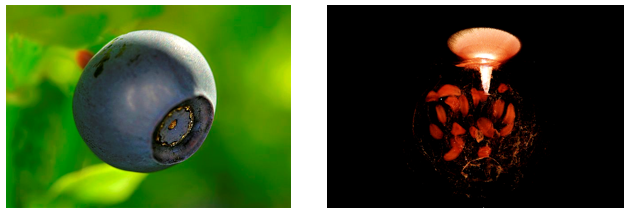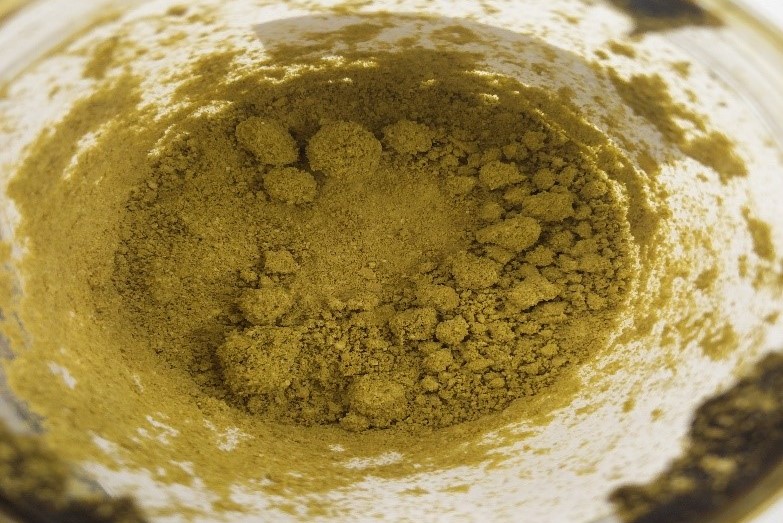Marketing Potential of a New Ingredient – Arctic Berry Wax – for Natural and Organic Cosmetics Industry

Photos of bilberry in nature and in lab: X-ray tomography image (Image by Ilkka Jaakola and Roberts Joffe)
Is there any market potential in a new ingredient of pure wild berries in natural cosmetics? In Provence, there are herbs, in the Canary Islands aloe vera, but the Nordic countries have wild berries in our forests! Berry oils have been studied a lot, but not the wax on the surface of berries, which is the focus in the WAX project – The Natural Wax of Arctic Berries as our Treasure. The Oamk team of the WAX Project is responsible for developing the business potential of Arctic Berry Wax in different industrial contexts. Possibly the biggest market potential resides in natural cosmetics. The team conducted market research at the Vivaness Trade fair in the spring 2018.
The Markets of Natural and Organic Cosmetics are Growing
Natural and Organic Cosmetic (NOC) products are gaining in market share worldwide due to increasing consumer interest in the ingredients used in cosmetics. The global market size of NOC was 9.6 billion USD in 2016, and the size of the market is growing by 5 % yearly. The most promising outlook is in Europe and North America, where consumers are increasingly concerned about the environment and their health. In Asia, important market areas include Japan and South Korea, where the focus is especially on personal wellbeing. In the cosmetics industry, green make-up is ’booming’: its market share is currently only 1 % of the global cosmetics market and it is expected to grow to 13% by 2021. (1)
What Does Green Really Mean in Cosmetics? Natural or organic?
Consumers associate green with clean and non-toxic; natural; unprocessed; sustainable for climate, protecting flora and fauna; vegan and cruelty-free. They are concerned about ‘greenwashing’, misleading marketing communication, which makes false claims about the environmental benefits of products. (2)
Some organisations monitor the market, while others provide certifications for products. Especially European consumers are interested in buying certified NOC products. The most common European standard, COSMOS – short for COSMetic Organic and Natural Standard – was created in 2002 to act as a harmonized standard. This standard is now a globally recognized standard for natural and organic cosmetics. (3)
Consumers are confused about natural and organic as terms in cosmetics, and this is also a challenge for the industry. Not all natural cosmetic products are organic. Organic cosmetic products contain certified ingredients, while natural cosmetics contain plant extracts and only a minimal amount of synthetic chemicals. Nature-inspired is a marketing term, which may involve e.g. packaging with a picture of a natural ingredient, such as a plant or a berry and a matching colour, but no more. Thus, the enlightened consumer will need to look for certification in their favourite cosmetic products or check the list of ingredients in order to verify the NOC quality.
Cosmetics Contain Waxes
The cosmetics industry uses plenty of waxes, because they provide stability and enhance the viscosity and consistency of cosmetic products. They also have emollient, protecting, film-forming and thickening effects and are thus resistant to moisture, oxidation and microbial degradation. Consumers come across waxes in lipsticks and beard waxes, to name but a few. The most used waxes in cosmetics are Candelilla wax, Carnauba wax and beeswax, of which the first two are imported from South America. Beeswax may be problematic for allergic consumers. (4)
What is Arctic Berry Wax (ABW)?

Photo of bilberry wax – extracted from berry side stream (Photo by Petri Sundqvist)
In the WAX Project, sustainable methods that enable extracting natural wax from Arctic berries are developed. In addition, berry waxes are analyzed and their chemical and physical characteristics are compared with other available waxes. Based on the research results now available, we can claim that the natural wax extracted from Arctic berries:
- is a high-quality natural ingredient,
- is vegan,
- preserves well, so fewer preservatives may be needed in end products,
- is free from chemical additives thanks to the sustainable extraction method available,
- grows in unpolluted forests,
- potentially has antimicrobial and antioxidant properties and
- is thermally quite stable.
Exploring the Market Potential of Natural Waxes in Cosmetics at a Trade Fair was Enlightening
The Oamk team of the WAX Project, which consists of staff and students of the Oamk Business Division, decided to explore whether Arctic Berry Wax would interest manufacturers of natural and organic cosmetics and wax manufacturers. Could a new alternative wax from Northern Europe that originates in Arctic berries have business potential? In order to explore the situation and share information about Arctic Berry Wax, the Oamk WAX Project team visited the International Trade Fair for Natural and Organic Personal Care, VIVANESS 2018, which takes place annually in Nuremberg, Germany. The trade fair has an admission restriction, which ensures that the audience is strictly professional. VIVANESS 2018 had 275 exhibitors, of which 66 per cent came from outside Germany. Besides, the trade fair offered Expert Lectures on latest trends in the NOC business and the possibility to connect with professionals in the field.
It was inspiring to gain access to the latest information on the trends of an entire industry, which is growing and gaining societal importance. The presence of professionals from various companies, including buyers of large companies, as well as start-ups and producers attempting to create contacts and generate sales leads with large distributors made the visit useful and well worthwhile for the WAX Project. NOC trends follow larger societal trends and customers’ points of view. The value propositions the customers are interested in are the starting point for the Cosmetics industry in its product development. To become competitive in natural cosmetics, companies will also need new business models, new distribution channels and Unique Selling Propositions. Developing selling propositions requires careful dialogue with target groups: enhanced communication via e.g. bloggers, authentic stories and pop-up stores.
Innovations and Latest Trends in Natural Cosmetics
Among the latest trends in cosmetics are Do It Yourself -cosmetic kits. A company called Coscoon, a small start-up, sells such kits with everything included, from ingredients to recipes and tools. Ecological and attractive packaging is an issue that should not be overlooked in cosmetics; the company representatives claimed that their sales started to increase, once they renewed their packaging. Another interesting company case is a German-Brazilian company Baims, which produces natural cosmetics: they have make-up lines that use wooden packaging instead of plastic. A Finnish company, Sulapac, has also created environmental packaging for cosmetics. Additionally, the formulations of natural cosmetics are improving and the product development of NOC products is intensively exploiting scientific research, according to VIVANESS 2018 Expert Lecturers.
Next Steps in Marketing Arctic Berry Wax
Based on our observations, VIVANESS 2018 Expert Lectures and interviews at the fair, it seems that there is general interest among buyers in the cosmetic industry in alternative ingredients. To become an interesting ingredient for cosmetic companies, Arctic Berry Wax needs to be approved for usage in cosmetics as a raw material. It needs to be developed into a product by providing technical details of its composition, as well as proof of origin or certification. Ideally, this would also include the creation of a marketing story, and companies could then proceed in their marketing via ingredient branding and co-branding with customers. (5)
The next steps of the Wax Project will involve sending samples of Arctic Berry Wax to interested cosmetic companies and wax manufacturers. We will also proceed to creating a pilot cream with a Nordic cosmetic company, and start assessing the patentability of the potential invention in the Project.
The WAX Project is a multidisciplinary joint project of Northern Universities (University of Oulu, Oulu University of Applied Sciences, Luleå University of Technology, NIBIO: Norwegian Institute of Bioeconomy Research) studying Arctic Berry Wax. The extracted natural wax from Nordic or Arctic berries is not, as yet, being industrially exploited. Especially synthetic waxes – as opposed to natural ones are used in many industries, such as the food industry, besides the cosmetics and packaging industries. These applications will also be studied later in this project.
More information on the WAX Project is available on the Project website at www.oamk.fi/wax
Taina Vuorela, Principal Lecturer, Business
Päivi Aro, Principal Lecturer, Business
Helena Ahola, Principal Lecturer, Business
Eva-Maria Schromm, Student of the Degree Programme in International Business
References
- WAX Project: Cosmetics. 2018. Interim Report.
- Smith, M. 2018. Director, NATRUE aisbl. Greenwashing? Nein danke! Wie vermittelt man die Vorteile zertifizierter Bio- und Naturkosmetik im Jahr 2018. Vivaness Congress, Nuremberg. Speech 15.2.2018.
- COSMOS 2018. The COSMOS standard. Cited 25.4.2018.
- Cosmetics analysis 2018. Synthetic Wax. Stiftung zur Förderung der Hautgesundheit. Cited 20.3.2018.
- Schromm, E-M. 2018. The business potential of Arctic Berry Wax as an ingredient in natural cosmetics : Case study of wax purchasing exhibitors at the Trade Fair Biofach Vivaness 2018. Thesis. Oulu University of Applied Sciences.












